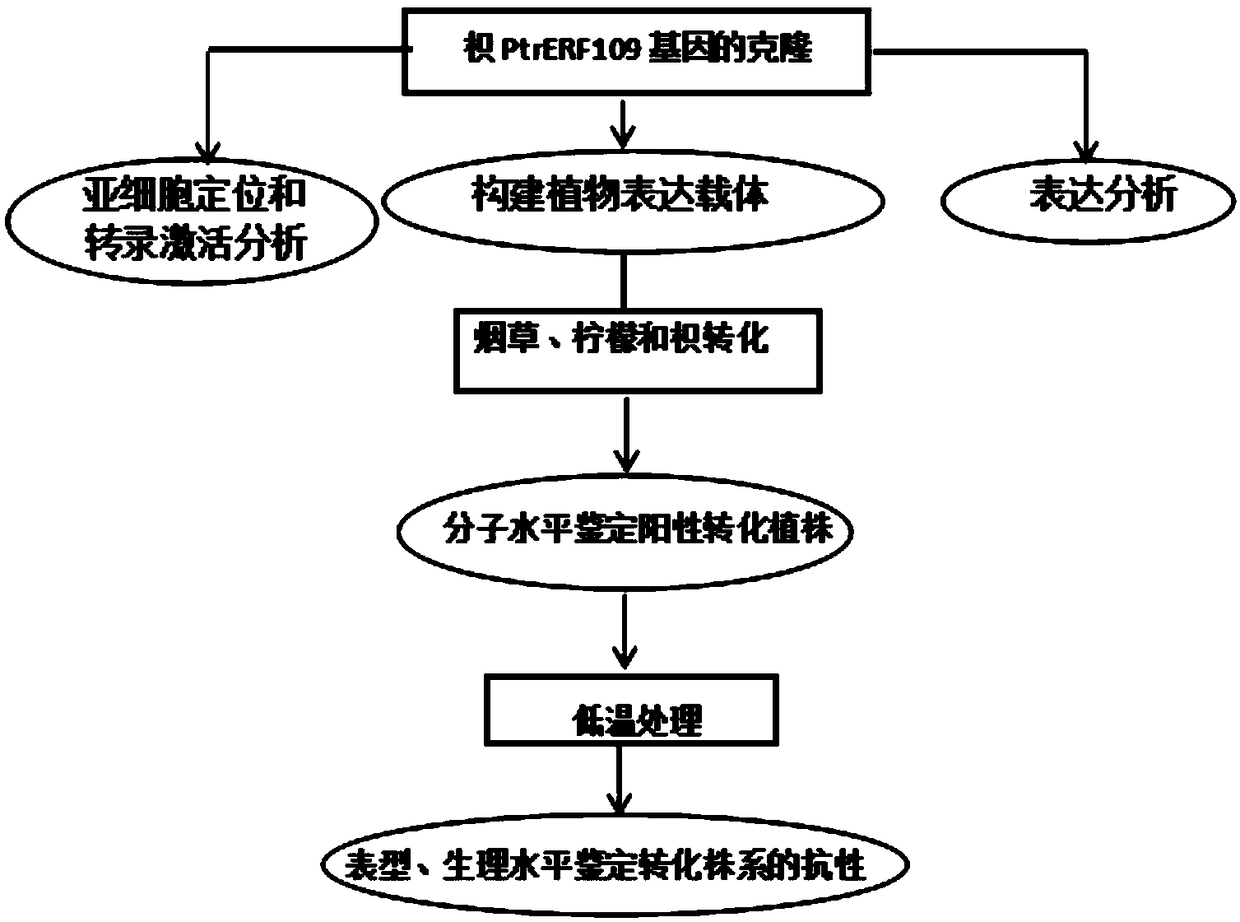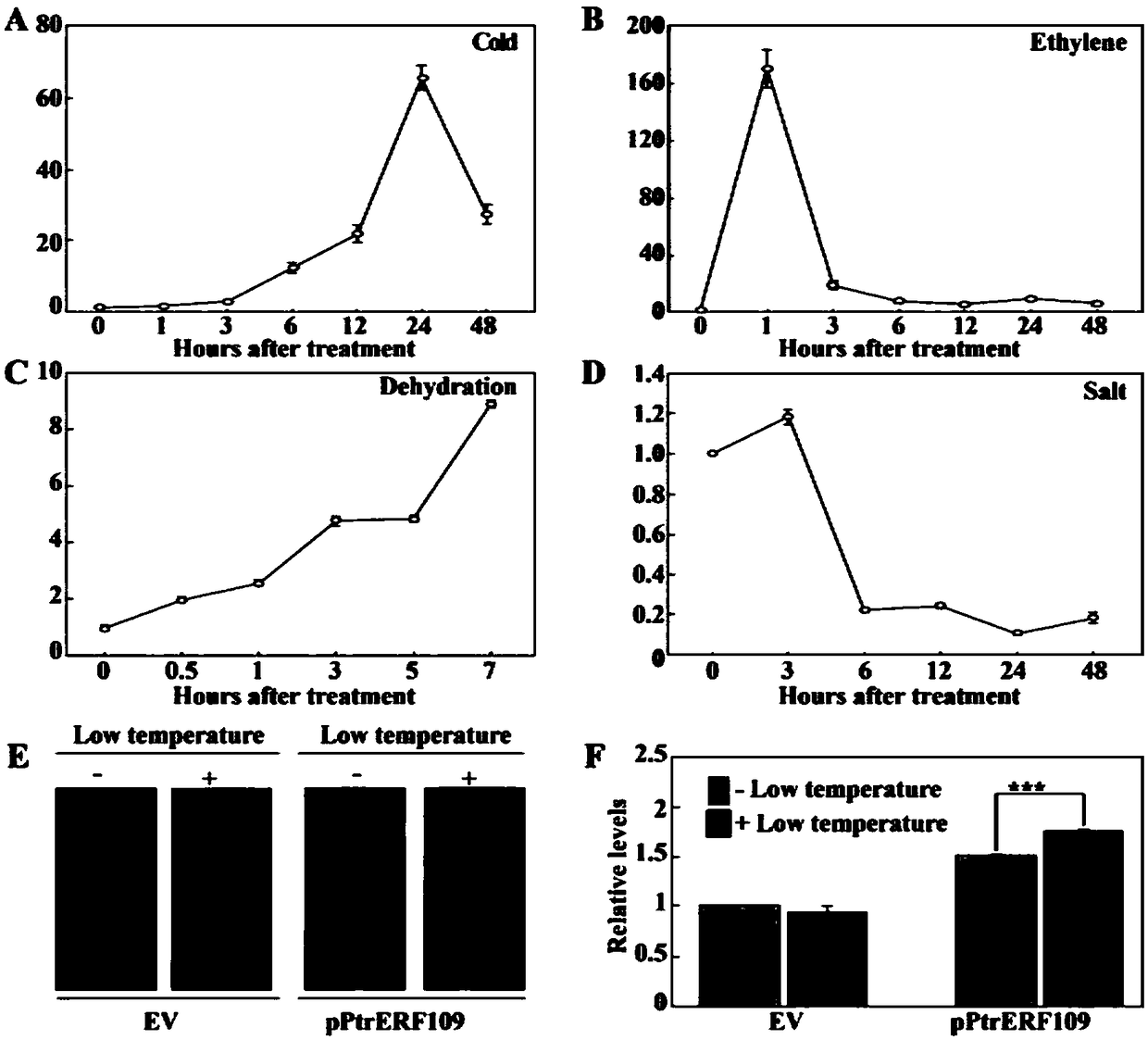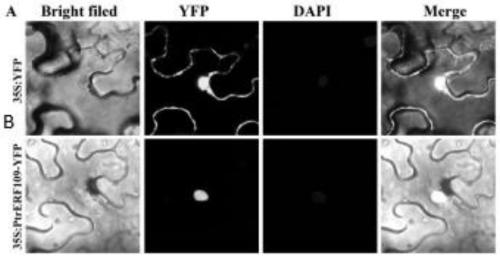Cold-resist gene PtrERF109 of trifoliate orange and application thereof in cold resistance genetic improvement of plants
A gene and plant technology, applied in the direction of plant gene improvement, application, plant peptides, etc., can solve problems such as unreported ERF transcription factors, achieve the effect of reducing agricultural production costs and achieving environmental friendliness
- Summary
- Abstract
- Description
- Claims
- Application Information
AI Technical Summary
Problems solved by technology
Method used
Image
Examples
Embodiment 1
[0065] Cloning of full-length cDNA of PtrERF109 gene in Hovenia trifoliate
[0066] Using Hovenia trifoliate cDNA as a template, high-fidelity enzymes were used to amplify. The amplification system is shown in Table 1, and the amplification procedure is shown in Table 2. The sequences of the amplification primers are:
[0067] PtrERF109-F:5'-ATTCCAGAGCCAACACGAAC-3'
[0068] PtrERF109-R:5'-GAACGTGGGATTTCGCCAGC-3';
[0069] AxyPrep-96 DNA Gel Recovery Kit (Axygene, USA) was used to purify and recover the amplified product, and the purified product was compared with 18-T vector (TaKaRa, Japan) was used for ligation, and the ligation system was shown in Table 3-3. After incubation at 16°C for 30 min, it was transformed into Escherichia coli competent Trans5α.
[0070] Table 1 Gene amplification system
[0071] Table 1 Reaction system of gene amplification
[0072]
[0073] Table 2 Gene amplification PCR program
[0074] Table 2 PCR program for gene amplification
[0075]...
Embodiment 2
[0085] qRT-PCR analysis of PtrERF109 gene under different stress conditions
[0086] The expression pattern of the PtrERF109 gene was analyzed by real-time fluorescent quantitative PCR (qRT-PCR), and the quantitative reagent was QuantiNova TM SYBRGreen PC (QIGEN, Germany), the method refers to the instruction manual, and the reaction system is shown in Table 5.
[0087] Table 5 Quantitative PCR reaction system
[0088]
[0089] Actin from Citrus trifoliate was used as an internal reference gene, and the cDNA obtained by reverse transcription was used as a template. Each sample was repeated four times, and the gene primers used in the reaction are listed in Appendix II. Quantitative PCR reaction in Applied Biosystems QuanStudio TM 7 Flex Real-Time PCR system (ABI, USA) was completed, and the reaction program is shown in Table 6. After the reaction, use 2 -ΔΔCtAlgorithms perform calculations on gene expression. The internal reference gene qRT-PCR primers are:
[0090...
Embodiment 3
[0098] Analysis of subcellular localization and transcriptional activation of PtrERF109 gene
[0099] The ORF region of PtrERF109 (without the stop codon) was amplified and constructed on the 101LYFP vector. The YFP protein was located at the 3' end of the gene, and the expression was driven by the CaMV35S promoter. 35S:PtrERF109-YFP and control 35S:YFP were transiently transformed into the leaf epidermal cells of Nicotiana benthamiana respectively, and laser confocal observation showed that the fluorescence of the control filled the entire epidermal cells, including the cytoplasm and nucleus, while the fluorescence of transformed 35S:PtrERF109-YFP Concentrated only in the nucleus, which was further confirmed by DAPI staining. In addition, cotransfection with mCherry fluorescent protein localized in the nucleus also obtained the same results, indicating that PtrERF109 is a nuclear localized protein (see image 3 A in A, B in 3).
[0100] It has been verified that PtrERF109 i...
PUM
| Property | Measurement | Unit |
|---|---|---|
| Molecular weight | aaaaa | aaaaa |
Abstract
Description
Claims
Application Information
 Login to View More
Login to View More - R&D
- Intellectual Property
- Life Sciences
- Materials
- Tech Scout
- Unparalleled Data Quality
- Higher Quality Content
- 60% Fewer Hallucinations
Browse by: Latest US Patents, China's latest patents, Technical Efficacy Thesaurus, Application Domain, Technology Topic, Popular Technical Reports.
© 2025 PatSnap. All rights reserved.Legal|Privacy policy|Modern Slavery Act Transparency Statement|Sitemap|About US| Contact US: help@patsnap.com



